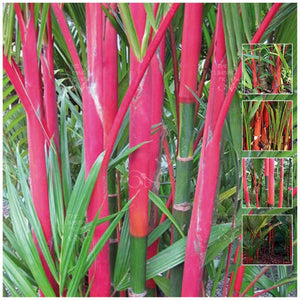Your Cart is Empty


Sold out
SP.OR.CYRRENR-0006
Cyrtostachys Renda Red Wax aka Lipstick Palm Seeds
Inc. GST + FREE Shipping
$5.59 - $9.59
Cyrtostachys Renda Red Wax / Lipstick Palm has got to be the most quintessentially exotic palms anywhere. It's bright red crownshafts and leaf sheaths provide tranquil colour that undeniably says; welcome to the tropics - now relax!, making it a popular choice for hotels, resorts, restaurants, particularly in the tropics, where this variety grows best. This beautiful palm is native to Thailand, Malaysia, Sumatra and Indonesia, but can be hard to come by in cultivation as it was listed as a vulnerable protected species on the IUCN Red List in 1995 (subsequently removed), making this a rare and highly sought after variety, particularly by keen collectors. At The Climbing Fig, we believe in conservation by collecting, so why not consider growing this stunningly majestic palm, and at the same time, do your bit to ensure our biodiversity is preserved. We've seen collectors pay more that $2.00 per seed or more than $1,000 for a single plant, however, we've been able to import wholesale quantities of this variety for a nursery client, and we are making additional stock available at our online store. The only drawback of this particular variety is that germination can be quite sporadic, with some seeds taking several months to germinate, particularly if conditions are suboptimal. For best results, we recommend soaking seeds for 24hrs before sowing, then planting deep into 30mm Jiffy coir pellets, preferably within our Plant Propagation Kit as elevated levels of humidity are important in germination of this variety. This variety does best in a sub-tropical to tropical environment, and in certain instances may be grown in cooler environments (once established), and should be considered an indoor plant in cold regions, particularly in southern Australia. Cyrtostachys Renda Red Wax / Lipstick Palm is also referred to as Cyrtostachys Lakka, as well as by the common names of Red Palm, Rajah Palm, and most notably Sealing Wax Palm, referring to the red colouration of the stems resembling red sealing wax used in the 15th and 16th centuries to seal regal envelopes.
Advantages of Cyrtostachys Renda Red Wax / Lipstick Palm
- Very stylish ornamental palm
- Ideal high-impact landscaping feature
- Most suited for tropical or indoor use
- Extra-low maintenance
Features
- 120 - 200cm height in the first 3-5 years, but can grow to 4m+ over the years (even taller in the tropics)
- 2m apart is suitable planting distance - although if going to be used as a screen, 1m spacing is more appropriate
- Will grow in part-shade but prefers full sun
- Generally drought tolerant
- Suitable for pots including indoor use (on rotation with outside) and most warmer regions of Australia particularly the tropics
Seed Sowing Instructions
- Easy to follow seed propagation notes are provided with every seed purchase
- Seeds of this variety are best started in ~30mm Jiffy® pellets before planting into the garden
What am I Purchasing?
- Premium seeds of Cyrtostachys Renda Red Wax / Lipstick Palm
- Easy to follow seed propagation notes










